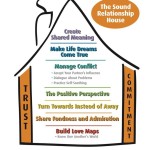
Building a Sound Relationship House
The Gottman Relationship Blog // March 4, 2015 // Zach Brittle, LMHC
The Gottman Institute’s goal is to utilize a research-based approach to create stronger relationships for couples and families. Understanding that all relationships go through phases, they’ve developed programs and resources to provide support throughout the entire lifecycle. For new parents, there is a program called Bringing Baby Home designed to help families make the transition to parenthood. For couples struggling with addiction recovery, they’ve recently launched a workshop called Roadmap for the Journey. Couples in the later stages of their relationship can purchase the 52 Questions After 50 Card Deck to help them manage the second half of their lives together.
Perhaps the most delicate time in any lifecycle, however, is the beginning. I’m really excited to shine a light on the early stages of a relationship with a new series we’re calling “New Construction.” Over the next few months, I’ll use this space to speak to how the Gottman body of research informs new relationships, specifically pre-marrieds and newlyweds.
Using the template of the Sound Relationship House, I’ll explore what it means to actually build a sound relationship using principles and processes discovered and described by The Gottman Institute. I’ll use the series to thoroughly explore the metaphor of new construction and offer specific, actionable perspectives for couples that will allow them to have their own constructive – i.e. creative, courageous, curious – conversations as they prepare for a lifetime together.
Ask anyone who’s ever built a house. It is both exciting and stressful. It’s also expensive, costing not only money, but also time, energy, and dream equity. With that said, careful planning and preparation can lead to a smoother process and a beautiful result. Let’s begin by considering the actual process of home building and its parallels to a relationship. Here’s what I learned from my contractor friend about the five major phases of the home building process:
- Stage 1: Foundation – Before the foundation is poured, there is a lot of work to do. The site must be graded and excavated and the foundation laid out according to the plot map. Rough plumbing is installed and inspected and, finally, the foundation for the house, garage, and porch is poured.
- Stage 2: Framing – This is when your house starts looking like a house. During this phase, all of the home’s interior and exterior walls and the stairs are framed. Now it’s time to keep the weather out by installing the sheathing, roof, shingles, exterior doors, and windows.
- Stage 3: Plumbing, Mechanical, Electrical – The work that happens during this phase has to be done right, because once sheetrock is put over it, everything will be harder and more expensive to get to. Water, waste piping, water heater, HVAC system, ductwork, and rough electrical wiring — the guts of your new home — are installed during this stage. All of these systems require inspection to assure you can safely move on to the next phase.
- Stage 4: Insulation and Drywall – First the walls are insulated and then the drywall or sheetrock is installed over them.
- Stage 5: Exterior and Interior Finish – In this phase, all the final details are taken care of, including installation and testing of electrical, mechanical, HVAC, and plumbing systems and the installation of ceilings, doors, baseboards, window sills, floor coverings, countertops, cabinets, tiles, appliances, mirrors, lights, faucets, and shower heads. Everything gets a covering of paint or wallpaper and the driveway and sidewalks are poured. Final inspections, both municipal and with your inspector, are performed now and landscaping is done.
Clearly there are many parallels between a new home and a new relationship. Beginning with a solid foundation is essential. This is what Dr. Gottman would call the marital friendship – the common courtesy and affection (or lack thereof) that is the basis for all subsequent interaction. The framing of the walls and weatherproofing are the systems of bids and turning toward that create the structure of the relationship. Plumbing, mechanical and electrical – the guts of the house – represent the positive perspective, the pervasive feelings of love, hope and goodwill that buffers the relationship from negativity and conflict. Conflict itself, is represented by insulation and drywall which are the ugly, hidden, but necessary, elements of a warm, secure home. Exterior and interior finish represent the beautiful, detail work of supporting dreams and creating shared meaning.

